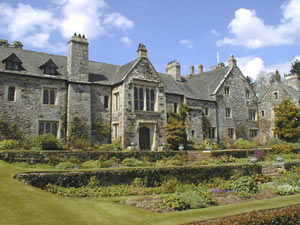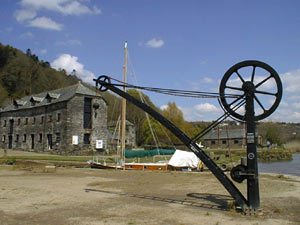

Cotehele, Cornwall was originally the home of the Edgcumbe family, now run by the National Trust. A tudor mansion, just west of Gunnislake, it has remained virtually unaltered since the addition of the tower in 1627. It is one of the least-altered mediaeval houses in the country, it still has most of its original furniture, tapestries and suits of armour.
The Edgcumbe family owned Cotehele for almost 600 years. Cotehele was enlarged and re-built in Tudor times by Sir Richard and Sir Piers Edgcumbe Another Richard Edgcumbe built another house at Mount Edgcumbe and moved the family there, with the result that Cotehele remained relatively unaltered. The facade of Cotehele was re-built in 1862 together with the terraces below.
The Edgcumbe family continued to own both Cotehele and Mount Edgcumbe for almost four centuries, until 1947, when death duties forced a choice. Mount Edgcumbe became their own residence, Cotehele a National Trust house.
Its 24 acre terraced gardens are pleasant, particularly the Rhododendrons. The Upper Garden has sloping lawns, herbaceous borders, a lily pool and a spectacular Tulip tree and a Tree of Heaven. Prospect Tower offers panoramic views of the Tamar. The rhododendrons, especially 'Cornish Red', and azaleas, magnolia, camellias, enkianthus and kalmias provide a memorable display in Spring. In the gardens are a restored medieval dovecote, a working watermill and a cider press.The large estate offers miles of riverside and woodland walks. The garden around the house is formal, although the area around the courtyards has hundreds of daffodils in season.

At Cotehele Quay, mooring for the last of the Tamar barges, there is a museum, tea rooms, a restored boathouse, and the Shamrock, one of the last of the stone carrying barges on the Tamar. A 57ft ketch-rigged vessel of 1899 then worked as a diving tender and salvage barge before being acquired by The National Trust in 1974. She is now co-owned by the National Maritime Museum who supervised her full restoration to sea-going condition. Though usually to be seen in her dock at Cotehele, she makes occasional voyages on the river Tamar. The adjoining Quay Museum tells Shamrock's story, as well as informing you about related industries of the Tamar Valley – mining, quarrying and shipbuilding.
There is working water mill by the Tamar quayside, and industrial ruins in the Danescombe valley.